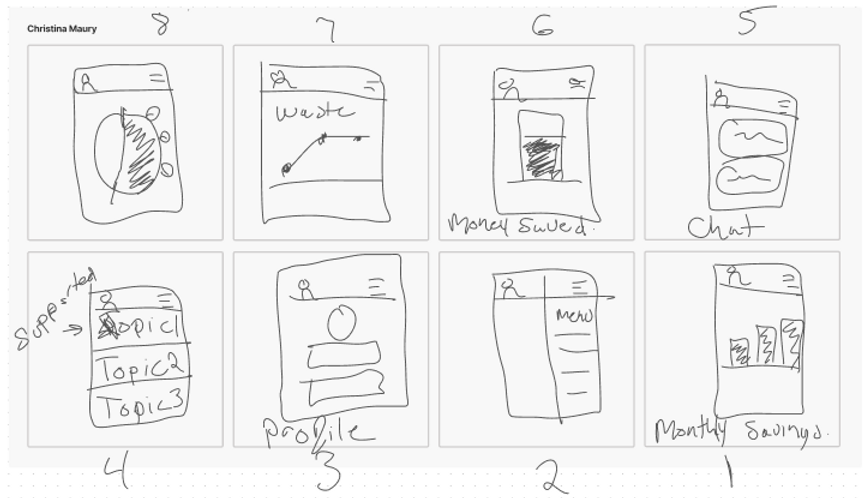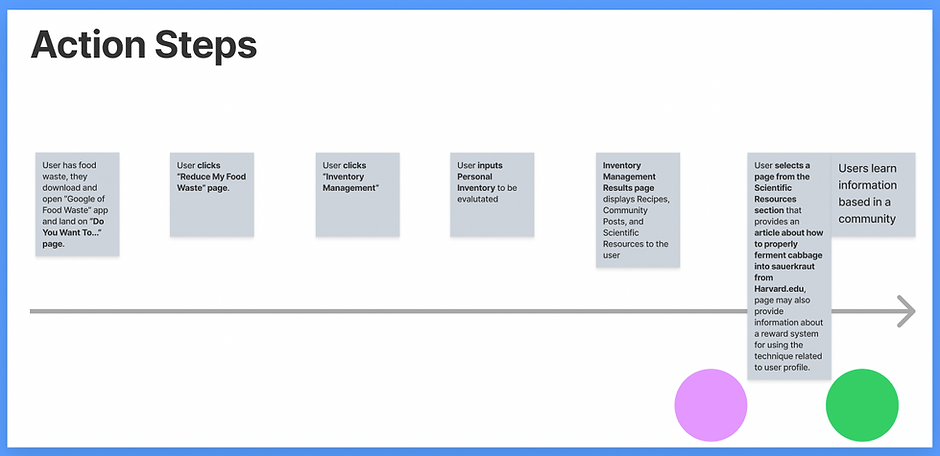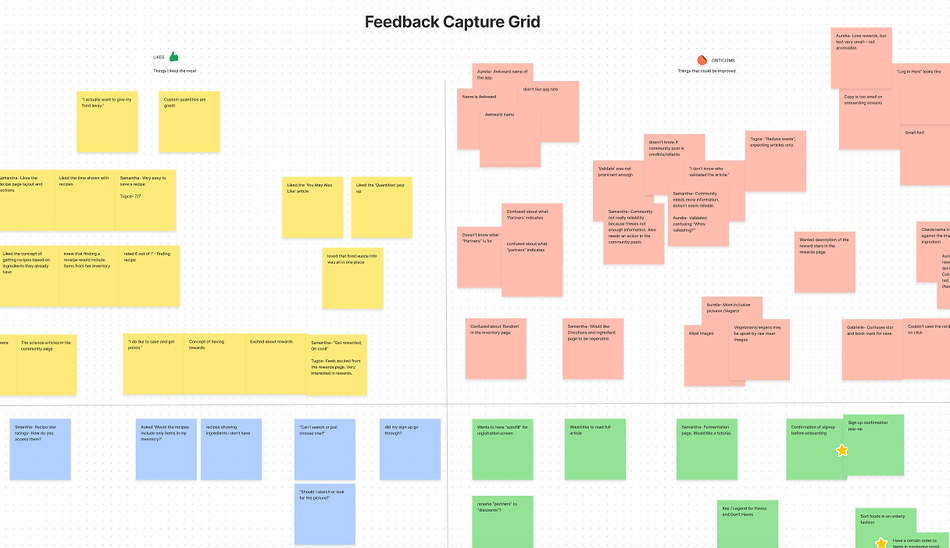


Context
Wastely is the result of a four-day design sprint conducted remotely by a group of designers from around the world who wanted to find a novel solution for reducing food waste. Our team came together when our facilitator, Christina Maury, reached out to the Design Buddies community with an invitation to collaborate on a Design Sprint according to the AJ&Smart Design Sprint methodology. The final team was made up of aspiring designers across the globe. To overcome the geographic barriers, Discord was chosen as our main communication platform because of it’s reliable video-calling services and free forums. To collaborate in real-time on the various stages of the Design Sprint and to create the prototype, both Figma and the new FigJam were utilized for the entire process.
The Sprint Team
-
Christina Maury, Facilitator and Group Organizer
-
Linh Le, Lead Designer and The Decider
-
Bob Ruediger, Lead Interviewer and Assumptions Board Manager
-
Christina Maresca, Lead Recruiter
-
Janice Jons, Designer and Researcher
-
Kathrina Tacastacas, Designer and Researcher
In addition to the listed roles, each member of the team assisted in creating the prototype as well as recruiting, interviewing, and note taking during the usability tests.
The Problem
Prior to starting the Design Sprint, democratic voting between the members was used to choose food waste reduction as the problem space to focus on. Issues like natural resource depletion, greenhouse gases, and the growing number of landfills are directly related to the amount of global food waste.
The Solution
Wastely is a food waste reduction app that makes it easy for users to find thousands of recipes, resources, techniques, and organizations aimed at reducing food waste. It rewards them for reducing their own waste at home and sharing their techniques with the community.

The Process
AJ&Smart’s Design Sprint was chosen for this project because it is the most up-to-date version of Jake Knapp’s process.

Day 1
Define the challenge
Produce a mass of solutions
Expert Interview
Ms. Alma Nejenhuis
Netherlands
• Co-op Founder
• Food Waste & Environmental Studies Educator
From our interview we learned that most food waste begins at home and there are a wide-range of obstacles that make it difficult to overcome this.
"There isn’t a convenient way for all people to access reliable information about what they can do with food they already have and how they can make smarter choices when buying groceries."
How Might We?
Reflecting on our interview, the team employed the “How might we…?” (HMW) method to determine our long term goals and our sprint questions.
How might we...
-
create a database of Waste Reduction Ideas and Recipes?
-
make the platform Accessible for Everyone Regardless of Social Status?
-
Encourage the Sharing Information and Ideas?
-
Shift Perspectives and Attitudes Towards Food Waste?
-
Overcome the Issue of Global Accessibility especially when there is limited internet access?
-
Reduce Waste?

Long-Term Goals
-
Provide a platform where anyone can share and retrieve helpful ideas
-
Make reliable information about food waste reduction accessible to all
Sprint Questions
-
Can we create a product that encourages people from all backgrounds to share creative food waste reduction ideas?
-
Can we reward users for sharing their ideas and information?
-
Can we ensure that the information is always safe and reliable?
To ideate and decide on a solution, Story Mapping, Crazy Eights, and The Final Concept were used to design a mass of potential product ideas.
Story Mapping

Crazy Eights

The Final Concept

My storyboard was called “Picture Perfect” and mapped the actions of somebody using an app to inventory the items in their fridge with their camera.
Day 2
Curate and vote on best solutions
Define the prototype with a storyboard
Final Concept Decision
To make a final decision, the straw poll method was used. First, each member was allowed a single vote and our decider was given time to examine everything one final time before casting the deciding “super vote.” Linh used her vote on a storyboard titled “The Google of Food Waste Reduction” which was designed by Christina Maresca.
The winning concept is an app with a simple home screen that affords users the options to give or receive unwanted food, to chat with other community members, and to learn ways to reduce their food waste.



3
1
2
User Test Flow
The first phase of creating a finalized user test flow was for each member to individually write six action steps. As was done with previous activities, the ideas were presented to the group for voting and in the end the action steps which I wrote were chosen to use as the foundation for our user test flow.

Storyboarding
Armed with our long term goals, sprint questions, final concept, and action steps, the rest of day two was dedicated to drawing the storyboard for our prototype. Our initial flow consisted of eight screens starting with an entry point of signing up for the app and the success criteria of users finding a reliable resource on the app for using the food they already have.

Day 3
Design and build the prototype
Recruit and schedule user tests
Prototype
Day three was devoted almost entirely to creating the prototype of our app for our user testing the next day. However, Christina Maresca also led the charge on recruiting the participants for the test and also assisted me in writing a finalized test script. The prototype itself was created using Figma and was worked on by the entire sprint team throughout the day
Home Page

Tailored Recipe Result

Food Inventory

Tailored Food Waste Reduction Post

Day 4
Test the prototype with 5 real users
Use feedback from testing to create clear next steps
Tasks
-
You have extra food that you want to find a use for...try to use the app to input the food you currently have in your fridge/pantry to get suggestions on what to do with it.
-
Now that you’ve added your food to the app, find a great meal idea for you to use after you come back from shopping later.
-
You want to see what other people are saying about alternative food waste reduction options such as fermentation...where would you go?
Participants
We specifically targeted participants who were responsible for the grocery shopping and meal planning in their household.
Aurelia K.
- 35+
- Visual Designer
- New Jersey, USA
Tugce G.
- 31-35
- Research Consultant
- London, UK
Gabrielle N.
- 25-30
- Purchaser
- Washington, USA
Kelsey L.
- 25-30
- Student
- Maryland, USA
Samantha L.
- 31-35
- Student
- Paris, France
"It's very easy to find and save recipes."
"The scientific articles seem more trustworthy than what I find on Google."
Feedback Capture Grid
During each user test, team members kept track of their insights on a voltage control spreadsheet and after the tests concluded, the insights were copied onto sticky notes to create a feedback capture grid on FigJam.

Likes
-
Inventory screen and tailored results
-
Social aspects and community pages
-
Gamification of reducing waste
-
Partnering with local markets and charities
Criticisms
-
Pages and functions were not explained
-
Inventory items not listed in a sensible order
-
It was unclear who “validated” the resources
-
Several UI elements would not meet accessibility standards
Ideas
-
Confirmation popup after registration
-
Ability to read full articles that are featured on the app
-
Provide a legend to show users what icons represent food you have or don’t have
Questions
-
How can I see who rated this and read their full review?
-
Where can I check how many points I have earned?

Reflection
Wastely was the result of the combined efforts of an enthusiastic, diverse team of aspiring designers who were willing to embrace the Design Sprint process in an effort to combat a “wicked” problem. The experience of working with a team on a design project was exciting and rewarding in a lot of ways. There were times when we felt stuck, but were able to overcome it through strong communication and positive encouragement.
During our first user test, the participant I was interviewing ran into a “dead end” in our prototype. In that moment, I was able to casually direct her to a previous page while other members of our team quickly fixed the issue before I “nudged” her back to the test flow. I think this moment encapsulates just how much our team came together in a short period of time to accomplish our goals. Overall, the product was very well received and the benefit was clear to all of our participants.
Conclusion and Future Steps
In the end, there were countless positive takeaways from this project. I am thankful to have been included in a fantastic team of designers who I am sure all have very bright futures ahead of them. For now, Wastely is a shelved idea but our team has not dissolved and future steps are already being considered.
At the very beginning of our planning stages, the team consisted of ten designers but we unfortunately lost four of our members to unforeseen circumstances. We hope to either bring back some of the original members or recruit other eager designers to join us for our next project. I would also like to try my hand at some of the other roles by either facilitating a Design Sprint myself or acting as “The Decider” in the future.


